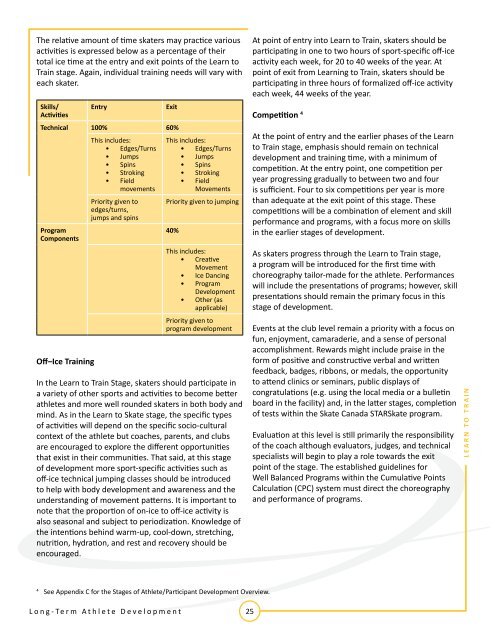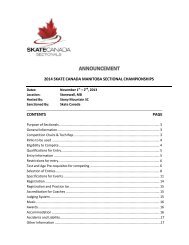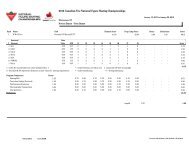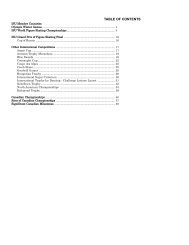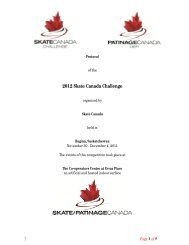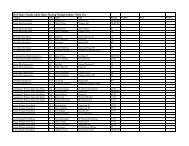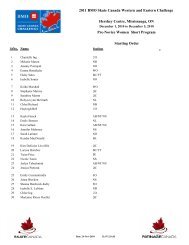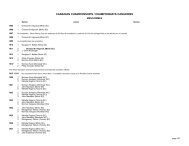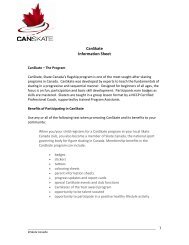LONG-TERM ATHLETE DEVELOPMENT - Skate Canada
LONG-TERM ATHLETE DEVELOPMENT - Skate Canada
LONG-TERM ATHLETE DEVELOPMENT - Skate Canada
You also want an ePaper? Increase the reach of your titles
YUMPU automatically turns print PDFs into web optimized ePapers that Google loves.
The relative amount of time skaters may practice various<br />
activities is expressed below as a percentage of their<br />
total ice time at the entry and exit points of the Learn to<br />
Train stage. Again, individual training needs will vary with<br />
each skater.<br />
Skills/<br />
Activities<br />
Entry Exit<br />
Technical 100% 60%<br />
Program<br />
Components<br />
Off–Ice Training<br />
This includes:<br />
• Edges/Turns<br />
• Jumps<br />
• Spins<br />
• Stroking<br />
• Field<br />
movements<br />
Priority given to<br />
edges/turns,<br />
jumps and spins<br />
L o n g - Te r m A t h l e t e D e v e l o p m e n t<br />
Phone 613.747.1007 I Toll Free 1.888.747.2372 I Fax 613.748.5718 I Toll Free Fax 1.877.211.2372<br />
This includes:<br />
• Edges/Turns<br />
• Jumps<br />
• Spins<br />
• Stroking<br />
• Field<br />
Movements<br />
Priority given to jumping<br />
40%<br />
This includes:<br />
• Creative<br />
Movement<br />
• Ice Dancing<br />
• Program<br />
Development<br />
• Other (as<br />
applicable)<br />
Priority given to<br />
program development<br />
In the Learn to Train Stage, skaters should participate in<br />
a variety of other sports and activities to become better<br />
athletes and more well rounded skaters in both body and<br />
mind. As in the Learn to <strong>Skate</strong> stage, the specific types<br />
of activities will depend on the specific socio-cultural<br />
context of the athlete but coaches, parents, and clubs<br />
are encouraged to explore the different opportunities<br />
that exist in their communities. That said, at this stage<br />
of development more sport-specific activities such as<br />
off-ice technical jumping classes should be introduced<br />
to help with body development and awareness and the<br />
understanding of movement patterns. It is important to<br />
note that the proportion of on-ice to off-ice activity is<br />
also seasonal and subject to periodization. Knowledge of<br />
the intentions behind warm-up, cool-down, stretching,<br />
nutrition, hydration, and rest and recovery should be<br />
encouraged.<br />
4 See Appendix C for the Stages of Athlete/Participant Development Overview.<br />
At point of entry into Learn to Train, skaters should be<br />
participating in one to two hours of sport-specific off-ice<br />
activity each week, for 865 20 Sheord to 40 Road, weeks Ottawa, of Ontario the year. K1J At 1H9<br />
point of exit from Learning to Train, skaters should be<br />
participating in three hours of formalized off-ice activity<br />
each week, 44 weeks of the year.<br />
25<br />
Competition 4<br />
At the point of entry and the earlier phases of the Learn<br />
to Train stage, emphasis should remain on technical<br />
development and training time, with a minimum of<br />
competition. At the entry point, one competition per<br />
year progressing gradually to between two and four<br />
is sufficient. Four to six competitions per year is more<br />
than adequate at the exit point of this stage. These<br />
competitions will be a combination of element and skill<br />
performance and programs, with a focus more on skills<br />
in the earlier stages of development.<br />
As skaters progress through the Learn to Train stage,<br />
a program will be introduced for the first time with<br />
choreography tailor-made for the athlete. Performances<br />
will include the presentations of programs; however, skill<br />
presentations should remain the primary focus in this<br />
stage of development.<br />
Events at the club level remain a priority with a focus on<br />
fun, enjoyment, camaraderie, and a sense of personal<br />
accomplishment. Rewards might include praise in the<br />
form of positive and constructive verbal and written<br />
feedback, badges, ribbons, or medals, the opportunity<br />
to attend clinics or seminars, public displays of<br />
congratulations (e.g. using the local media or a bulletin<br />
board in the facility) and, in the latter stages, completion<br />
of tests within the <strong>Skate</strong> <strong>Canada</strong> STAR<strong>Skate</strong> program.<br />
Evaluation at this level is still primarily the responsibility<br />
of the coach although evaluators, judges, and technical<br />
specialists will begin to play a role towards the exit<br />
point of the stage. The established guidelines for<br />
Well Balanced Programs within the Cumulative Points<br />
Calculation (CPC) system must direct the choreography<br />
and performance of programs.<br />
L E A R N T O T R A I N


